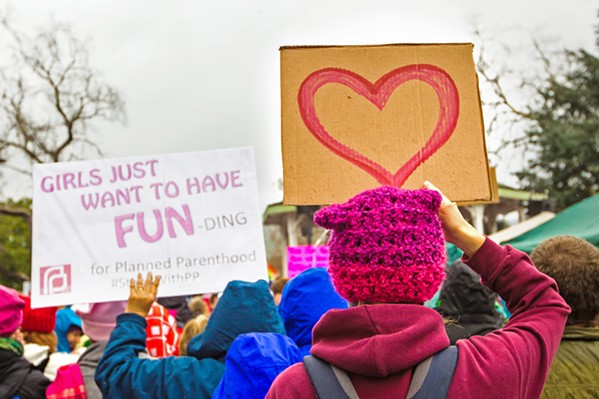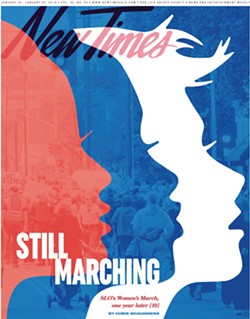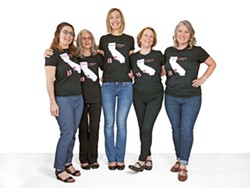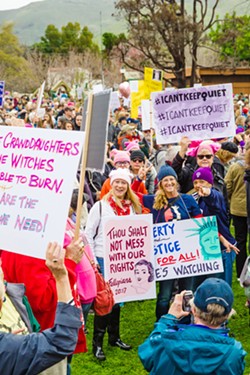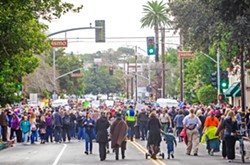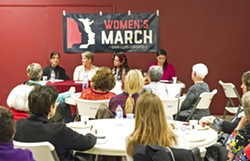[{
"name": "Ad - Medium Rectangle CC01 - 300x250",
"id": "AdMediumRectangleCC01300x250",
"class": "inlineCenter",
"insertPoint": "8",
"component": "2963441",
"requiredCountToDisplay": "12"
},{
"name": "Ad - Medium Rectangle LC01 - 300x250",
"id": "AdMediumRectangleCC01300x250",
"class": "inlineCenter",
"insertPoint": "18",
"component": "2963441",
"requiredCountToDisplay": "22"
},{
"name": "Ad - Medium Rectangle LC09 - 300x250",
"id": "AdMediumRectangleLC09300x250",
"class": "inlineCenter",
"insertPoint": "28",
"component": "3252660",
"requiredCountToDisplay": "32"
}]
Correction: The date for the "Hear our vote" rally was incorrect. This story was changed to reflect that the rally will be held on Jan. 20.
Jan. 21, 2017, was cold, windy, and rainy.
Just one day after the inauguration of President Donald Trump, between 7,000 and 10,000 people gathered under the darkening sky at Mitchell Park in SLO. The crowd was a sea of color cast against the gray clouds: Pink knitted hats and bright-colored signs with phrases like "The question isn't who's going to let me. It's who's going to stop me?" stood out in the gloom.
They were ready to join more than 5 million other individuals across the United States participating in the 2017 Women's March. The massive turnout in SLO was a surprise to many of the marchers themselves, including 25-year-old Rosie Guzman.
"I was watching everyone around me and in the bigger cities getting fired up, [and] I saw they were going to do a march in SLO, so I thought, 'Why not join?'" Guzman said. "Being at the march and seeing all those like-minded people gave me hope."
Behind that sense of hope were the five local women responsible for organizing the march and forming the organization known as Women's March San Luis Obispo.
"We are excited and inspired and grateful that so many people in the community are still engaged and want to work with us," said Dawn Addis, one of the five co-organizers of Women's March SLO. "It's just been amazing to see that many, many of the people that came out [to the original march] are still with us."
The 2017 march helped spark a renewed wave of political activism in SLO County, with the Women's March SLO participating in a slew of rallies, vigils, workshops, and other events while building a list of more than 10,000 individuals who it could inform and mobilize via email and social media along the way. So visible was their work over that last year that some government officials took note, with the city councils of four SLO County municipalities declaring January 2018 "Women's March San Luis Obispo Month."
"To
And even as they receive accolades from public officials, 2018 won't be a time of rest for Addis and her co-organizers Andrea Chmelik, Pat Harris, Jen Ford, and Terry Parry. There is still work to be done, they say. In 2018, much of that work will center on getting out the vote and encouraging more women to run for elected office.
"You have to pay attention every day. ... It's not going to be, 'Oh we won this and now we're done and we can just go out and get cocktails and live happily ever after,'" Chmelik said.
A year of action
Much of the
The first of those occurred Feb. 1, just 11 days after the march itself, in response to an attempt by the Trump administration to ban travel from several predominantly Muslim countries. More than 300 people packed the plaza in protest of the proposed travel ban and in support of the Muslims and other refugees it targeted. In April, the group organized another vigil to raise awareness and show support for Syrian refugees.
After a deadly clash between white supremacists and activists in Charlottesville, Virginia, the group once again helped pack Mission Plaza to hold a peaceful vigil in memory of Heather Heyer, a young woman who'd been killed. In October, Women's March SLO rallied its resources to help organize a phone bank to ask politicians to address problems with the government's response to Puerto Rico after the island was hit by a Category 5 hurricane.
In total, Women's March SLO organized or co-organized at least 15 events in 2017 including rallies, workshops, outreach programs, discussion panels, and vigils.
"I don't think we thought we would be doing an event or rally every two weeks, ... but as long as events are happening, we will be responding to them," Harris said.
Many of those actions were set off by current affairs, and many of the events that Women's March SLO organized last year were in partnership with other organizations that were looking to leverage the group's large social media presence and organizing clout to bring attention to issues that impacted people on a local level.
If their needs or cause aligned with Women's March founding principles—which highlight issues like equality, reproductive rights, non-violence, and the rights of women, workers, people of color, and the LGBTQIA community among others—then the group would do what it could to help.
"Even if we couldn't get involved directly, we would at least try and get the word out," Chmelik said.
A helping hand
For some of the individuals who came to Women's March SLO for help, access to the group's support and organizational knowledge offered them a chance to amplify their voice on issues close to their hearts.
Grisel Puig-Snider said she felt hopeless in the aftermath of the hurricane that devastated Puerto Rico, where she was born and where several members of her family still live. When she decided to organize a phone bank to ask politicians to increase aid and disaster relief to the island, she reached out to Addis and the Women's March for help.
"I didn't think anyone was going to show up, but it turned out to be 50 people. I still get emails about it," Puig-Snider said. "I would not have been able to do what I did
According to the Women's March SLO organizers, that support is a two-way street. While the group has reached out to assist individuals and organizations that need help, they too have benefited from individuals motivated or inspired by the march and looking to make a difference.
One of those is Morro Bay resident April Elliott. After attending the 2017 march in SLO with her mother and 14-year-old daughter, Elliot said she was inspired by the event and began looking for a way to contribute to the burgeoning movement.
"I thought it was important to do something more than simply attend [the march]," Elliott said.
That chance came when Elliott, a graphic designer by trade, offered to create a logo for the Women's March SLO's "Hear our vote: Voices of resistance" rally scheduled for Jan. 20.
"This was the perfect niche for me," she said.
Addis and her fellow co-organizers have several such stories of Women's March participants offering assistance in the hard work of organizing and activism. Sometimes that help comes in unexpected ways, as when the group had to figure out how to provide bathroom facilities for the thousands that showed up to the 2017 march—they received a generous donation of portable toilets from Harvey's Honey Huts. The same company is once again donating the facilities for the Jan. 20
"Everyone can't do everything, but everyone can do something," Harris said.
That attitude of support and cooperation allowed Women's March SLO and others to put important issues like Puerto Rico, immigration, women's rights, and gender and racial equality visible in the public eye throughout the year. That visibility is likely one of the reasons why the Women's March movement in SLO continued its momentum long after the original post-election march. Along with efforts by other groups like the SLO Progressives, RACE Matters SLO, and SLO Solidarity, The Women's March helped foster a resurgence of energetic progressive political activism in SLO during 2017.
"I think people to a certain extent in the local community have started to internalize activism as a way of life, and internalized this idea that you can interact with your government," Addis said. "I think people see activism as less scary and more a normal part of democracy here in their local community."
Victories and defeats
While the Women's March SLO accomplished a lot in 2017, the year wasn't without
Amid a national crackdown on undocumented immigrants by the Trump Administration and ICE, the Women's March suffered a tough loss late in the year after attempting to help a Grover Beach mother of three from being deported to Mexico. Despite efforts by the Women's March and others to aid the woman, who had been living in the United States for 25 years on a series of temporary work permits, she was still ultimately deported in early January, separating her from her children who are now left to fend for themselves.
While the events were disheartening, Addis said the group's work on the issue is far from done.
"If we stop doing the work, that's not going to help anybody," Addis said. "It's devastating, but you can't stop trying to move forward because that wouldn't help her and it wouldn't help her children, and it won't help people in a similar situation. It's long-term work and you have to keep going."
Harris echoed a similar sentiment, noting that it probably won't be the last time the issue of deportation will impact individuals and families in SLO County.
"We will keep fighting," she said. "Because it is bound to happen again, which is depressing."
Finding a way to deal with the ups and downs of the resistance movement in 2017 wasn't just limited to the march's organizers. The energy necessary to mobilize and fight as crisis after crisis loomed raised concerns about burnout and fatigue, leaving some to wonder if the national movement sparked by the march might fizzle out.
Shawna Marie, a local musician
"One of the major lessons is to persist in the resistance," she said. "This isn't a one-time gig and then every thing's fixed ... in order to make a difference and to put this energy out there and continue to do this kind of work, you also have to take care of yourself."
Harris indicated that the wave of energy she saw last January from the march's participants was still going strong.
"Every day you wake up and there's something else to be worried about. But I don't think it's really getting them to the point where people are just staying in their houses and being upset," she said. "I think they're still fired up. I don't think that's going to go away."
From the streets to the ballot box
Women's March SLO organizers are turning their attention and energy to 2018, ringing in their one-year anniversary with the Jan. 20
The rally isn't simply a celebration of the original march. It represents what will be a major focus for Women's March SLO in 2018: getting out the vote for the elections in November and beyond.
"We want to get people to think about who they are voting for and why they are voting for them," Harris said. "With us and so many other groups doing the same thing, I believe we can create a wave and get people into elected office."
Harris' comments raised another important aspect of the organization's plan for the 2018 elections: making sure that a good portion of that wave includes women candidates. Currently, women hold just 19.6 percent of the seats in the U.S. Congress. In the country's state legislatures, that number is only slightly higher, at 25 percent.
"We are looking at the role of gender equality in getting political wins in 2018," Addis said. "So as much as we are trying to get out the vote, we're also focusing on getting more women into office."
On Jan. 11, the group held a "practical politics soiree," inviting attendees to hear from a panel of local women elected officials, including SLO Mayor Heidi Harmon, former SLO County supervisor
The Women's March will hold a Breaking Barriers workshop on Jan. 25, aimed at giving participants the knowledge and tools to take action and elevate more women into local roles of leadership and power.
That goal won't likely be limited to the 2018 elections. And like the tough issues they tackled last year, the work won't be easy. Still, the Women's March SLO organizers, and the thousands of people who showed up on that rainy day nearly 12 months
"I think this is something all of us are in for the very long term," Chmelik said. Δ
Staff Writer Chris McGuinness can be reached at [email protected].
Latest in News
Readers also liked…
-

Coast Unified teachers upset over new position's salary and qualifications
Oct 20, 2022 -

SLO police identify alleged driver who hit and killed couple
Dec 22, 2022 -

When the levee breaks: Oceano residents, county officials walk a tightrope of regulations to manage Arroyo Grande Creek, which some say led to the levee's failure in January
May 18, 2023

